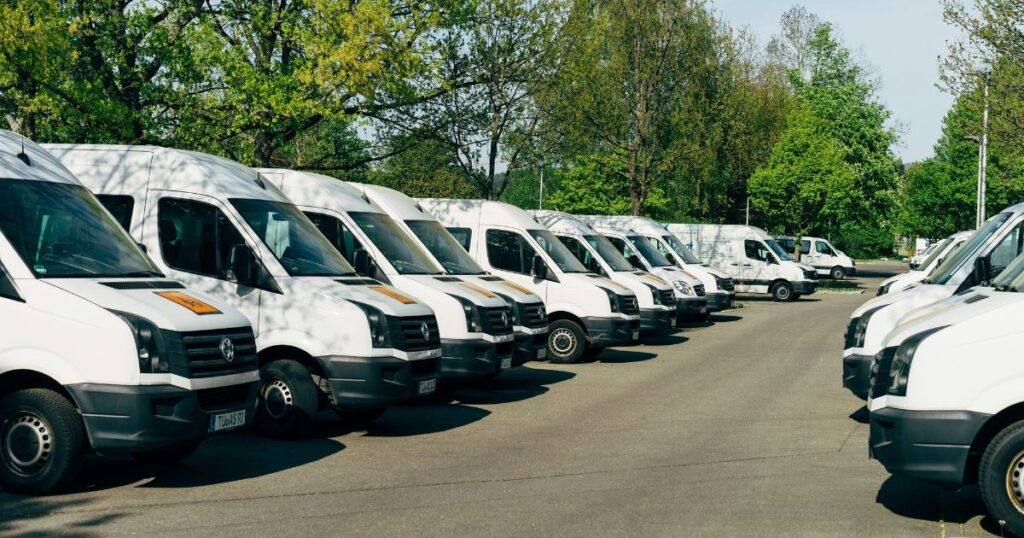Fleet insurance is a specialised type of cover designed for businesses that operate multiple vehicles. Whether you manage a small business with just a handful of cars or oversee a large operation with hundreds of vans, trucks, or other vehicles, fleet insurance can simplify your insurance needs and potentially save you money. But how does fleet insurance work, and what do you need to know to make the most of it? This guide will walk you through the basics and answer some of the most common questions.
Before diving into how fleet insurance works, it’s essential to understand what it is. Instead of insuring each vehicle separately, businesses can group all their vehicles into one policy, simplifying administration and often reducing costs. Read our blog for more details on what fleet insurance is.
So how does fleet insurance work?
Fleet insurance works by providing cover for all vehicles owned or operated by a business under one comprehensive policy. Here’s a breakdown of how it works:
- Single policy for multiple vehicles: Instead of juggling multiple policies with different renewal dates and cover levels, fleet insurance allows you to consolidate everything under one policy. This simplifies the management of your insurance needs and can reduce the risk of missed renewals or inconsistent cover.
- Flexible cover options: Fleet insurance policies can be tailored to your business’s specific needs. You can choose from different levels of cover, such as third-party only, third-party fire and theft, or comprehensive cover. This flexibility means you can get the right protection for all your vehicles, whether they’re cars, vans, lorries, or specialised vehicles.
- Covers drivers, not just vehicles: Fleet insurance typically provides cover for any driver who has permission to use the vehicle. This means that you don’t need to list every driver individually, which is particularly useful if your drivers change frequently or if you have a large number of drivers. However, you can opt for policies that limit the cover to named drivers only if that better suits your business needs.
- Customisable for different vehicle types: Many businesses operate a mix of vehicle types. Whether you run a delivery service with a mix of vans and motorbikes or a construction company with lorries and heavy machinery, fleet insurance policies can be customised to cover a diverse range of vehicles under one policy.
- Cost-effective: One of the primary benefits of fleet insurance is the potential for cost savings. Insuring multiple vehicles individually can be expensive and time-consuming, whereas fleet insurance often comes with bulk discounts and reduced administrative costs. Additionally, if your business has a good claims history, you may benefit from lower premiums.
Who needs it?
Fleet insurance is ideal for any business that operates multiple vehicles. This includes:
- Small businesses: Even if you only have two or three vehicles, fleet insurance can be more convenient and cost-effective than managing separate policies.
- Large businesses: Companies with large fleets benefit from the simplified administration and potential discounts that come with insuring many vehicles under one policy.
- Businesses with diverse vehicle types: If your business operates a variety of vehicles, fleet insurance allows you to cover them all under one policy, regardless of their make, model, or purpose.
- Businesses with many drivers: If your drivers frequently change or if multiple employees drive the same vehicle, fleet insurance simplifies managing cover and reduces the risk of drivers being uninsured.
Types of insurance
Fleet insurance policies can vary significantly based on the level of cover you need. The main types include:
- Comprehensive cover: This is the highest level of protection, covering damage to your vehicles, theft, fire, and third-party liability.
- Third-party, fire and theft: This covers third-party liability, as well as damage to your vehicles from fire or theft.
- Third-party only: The minimum legal requirement, this covers damage or injury caused to third parties but doesn’t protect your vehicles.
Factors affecting fleet insurance premium
Several factors influence the cost of a fleet insurance policy:
- Number of vehicles: More vehicles usually mean higher premiums, but the cost per vehicle often decreases as the fleet size increases.
- Vehicle types: The make, model, and purpose of your vehicles can affect your premium. For example, high-value or specialised vehicles may cost more to insure.
- Driver history: Insurers will consider the driving history of those covered under the policy. A clean record can lead to lower premiums, while a history of accidents or claims can increase costs.
- Usage: How and where your vehicles are used also affects your premium. Vehicles used for high-risk activities or in high-traffic areas may cost more to insure.
- Claims history: A business with a history of frequent claims will likely face higher premiums. On the other hand, a good claims history can result in discounts.
Summary
Understanding how fleet insurance works is crucial for any business that relies on multiple vehicles. By consolidating your cover into a single policy, you can simplify administration, reduce costs, and ensure that all your vehicles and drivers are adequately protected. Whether you’re a small business owner or manage a large fleet, investing in the right fleet insurance policy is essential to keeping your operations running smoothly.
Fleet Insurance
Our fleet insurance is designed to ensure your business vehicles are well-protected. Get in touch for a quote and explore cover for your fleet.


